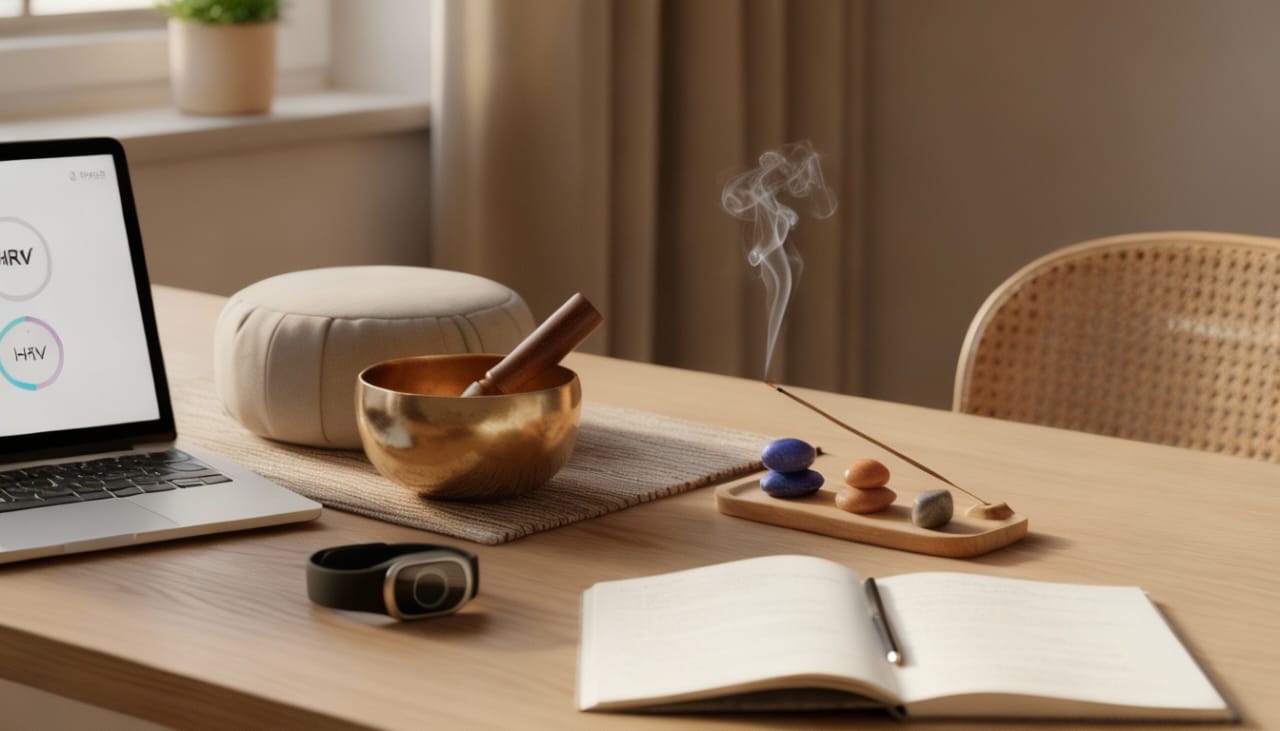Wellness used to mean going to the gym twice a week and maybe lighting a scented candle on Sunday. That definition is dead.
Over the last few years, we’ve watched the wellness industry collide with something it never used to touch: systems thinking. Optimization. Data. In other words — tech thinking. People don’t just want to “feel better” anymore. They want to consciously shape their internal state the way a founder shapes a product roadmap.
That shift has created a huge new category: inner tech.
Inner tech is anything that helps you regulate mood, focus, stress level, sleep quality, and emotional resilience — deliberately, repeatably, and on demand. Sometimes that looks like wearable trackers and HRV dashboards. But more and more, it also looks like something that seems completely opposite of digital: traditional energy practices, meditation tools, and sound-based relaxation.
Here’s the interesting part: those two worlds are not actually in conflict. They’re merging.
From “fix my stress” to “tune my system”
If you talk to burned-out professionals, founders, or high-pressure creatives, you’ll hear less “I need a vacation” and more “I need to stop running in sympathetic mode all day.” People know the language now. They’re aware of cortisol. They can tell you whether they’re stuck in fight-or-flight.
That’s a huge mindset change. Ten years ago, “I’m anxious” was a feeling. Today, it’s a dashboard reading.
Because of that awareness, we’re seeing more demand for practical, repeatable ways to shift state. Breathwork, chakra balancing, guided meditation, vibration/sound therapy, grounding rituals — these aren’t “New Age accessories” anymore. They’re being treated like usable protocols.
This is where platforms and shops that specialize in spiritual and meditation tools are quietly winning. They’re not just selling pretty objects. They’re selling state-control infrastructure for people who actually measure their stress level and sleep quality.
If you want an example of how this is packaged in 2025, explore Alvita.ch — a Swiss-based shop that focuses on items like meditation cushions, yoga mats, singing bowls, chakra tools, and sacred geometry pieces. These are classic tools, but they’re being positioned in a very modern way: not as décor, but as hardware for nervous system regulation.
Sound as a system reboot
Let’s talk about one specific tool that’s exploding right now in founder circles and among knowledge workers: singing bowls (often called “Klangschalen” in German-speaking regions).
The basic idea is simple. A metal or crystal bowl is gently struck or circled, it produces a resonant tone, and that tone creates a physical response in the body. Most people describe it as “my shoulders dropped immediately” or “my thoughts stopped looping for a minute.”
From a tech perspective, here’s why that matters.
When you’re stressed, your system narrows. You go into high-alert pattern recognition, shallow breathing, muscle tension, and a kind of aggressive tunnel-vision focus. It feels productive, but it’s not sustainable. You can’t create well from there. You can’t make long-term decisions from there.
Low-frequency resonance from a singing bowl does something extremely valuable in that moment: it interrupts that loop without needing a screen, a pill, or a 45-minute break. It’s fast. You can do it at your desk.
That is inner tech.
It’s also why we’re seeing meditation accessories move from yoga studios into actual work environments. If you walk into certain design agencies, co-working lofts, or product teams right now, you will sometimes find a corner with a cushion, a mat, an incense dish, and a bowl. That’s not “vibes.” That’s an off-switch station.
Energy work without the eye-roll
Let’s touch the word “chakra,” because five years ago that word would have lost half the room in a business context.
Today, the conversation is different. Founders talk very openly about “feeling blocked in the chest,” “carrying tension in the gut,” or “not being grounded.” They may not call it “heart chakra,” “solar plexus,” or “root,” but they’re describing the same map.
This is where ancient frameworks and modern performance culture are colliding. The chakra model, for example, gives stressed people a structured mental model of their own energy and attention. It’s basically an internal UX map.
And that’s key: people who live in product thinking love maps.
So when someone says, “I can’t speak clearly in this meeting, my throat feels tight,” calling that a throat-center imbalance (versus “I’m just off today”) gives them something actionable to work on. Sound work, guided focus, posture, breath. That’s more useful than “man up” or “relax.”
Again: inner tech.
Shops that curate chakra-focused tools aren’t just catering to spiritual seekers anymore. They’re supporting a new kind of self-regulation workflow: identify the bottleneck (anxiety, overwhelm, mental noise), then apply the correct physical/energetic input (grounding, vibration, aromatics, breath support).
The quiet opportunity
If you zoom out, the next wave in wellness isn’t purely biohacking and it’s not purely spirituality. It’s the merger.
It’s the founder who tracks sleep and Oura scores — and also keeps a meditation cushion next to the desk.
It’s the designer who does red light therapy in the morning — and uses a singing bowl for three minutes before a pitch.
It’s the marketing lead who says “my root is chaotic today” instead of “I’m just stressed,” and then actually does something about it.
Where does that leave the market?
It leaves space for brands that can speak both languages: grounded, practical, performance-oriented… and still honest about the fact that humans are energetic, emotional systems, not just brains on Wi-Fi.
That’s exactly why curated marketplaces of meditation gear, chakra tools, yoga mats, incense, and sound bowls are quietly becoming infrastructure for high-output people, not just décor for boho apartments. If you want to see how that positioning looks in practice — real physical tools, presented as everyday regulation tech instead of mystical collectibles — Explore Alvita.ch.
Because here’s the truth: the next competitive edge isn’t just faster thinking. It’s calmer thinking on demand.




























